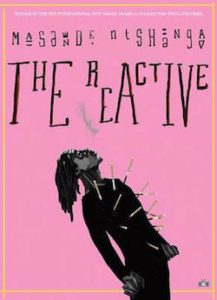
Youth is all about waiting. It’s terrible, despite all the pretty advertisements to the contrary. Except you have friends, and along with them you create something out of all that boring time, something resembling the life you imagine you ought to be having—drinking, drugs, sex, loud music, riding around in the fastest car you can get your hands on with trash rolling out from underneath the seats every time you make a sharp turn. All this, while you wait.
The Reactive by Masande Ntshanga is a novel of youth. Lindanathi is biding his early twenties away in Cape Town working a shit job at a video store. “Hours” he says, “have become something foreign to me.” Lindanathi is HIV positive, huffs, snorts, and smokes every drug he can get his hands on, wanders in and out of parties, and believes he is responsible for the death of his younger brother ten years ago. “I wasn’t there when it happened,” Lindanathi confesses in the book’s first paragraph. The line could be applied to almost everything that follows—there’s a distance between the character and his life that seems partially to do with narcotics, but more to do, perhaps, with his inability to move on from the events of his childhood. This distance lends a surreal tone to a book that sucks us like vapor through the streets of Cape Town along with Lindanathi and his two bosom friends—the forthright and artistic Cissie, and the constantly stoned and criminally minded Ruan.
The Reactive is partially a caper novel—the three friends moonlight as small time hustlers, selling the anti-retroviral drugs that Lindanathi scams and hordes (the novel is set before these drugs were broadly distributed in South Africa). When a mysterious client offers to buy their entire surplus, one might assume they’re being lured into a trap, either by a drug syndicate or the long arm of the law, but this plot device does little more than provide an excuse for the Lindantahi and his friends to argue, meander through the city, and finally meet a masked kingpin who isn’t as threatening as he is slippery.
After one fascinating scene in which our protagonists meet the kingpin in a room above a restaurant, he disappears along with his money and its promises. “He’s just one of this city’s many ciphers,” Lindanathi says, “one of the strange things that happen in the alleyways of the Southern Penisula.” I sometimes found myself wishing the masked man amounted to more than he does, and that the book had a bit more narrative snap, the relief of suspense that comes with a flash of violence, a narrow escape, maybe some moral brinksmanship. But there are other pleasures to be had here, as Ntshanga weaves a diaphanous fabric out of narrative devices—like point of view, the novel’s sense of time, and intermingling with African folklore.
The primary satisfaction of the novel is in experiencing Cape Town through Lindanthi. In the novel, Lindanathi observes, “Time seems to speed up…and then it stalls, and then it seems to speed up again before it stalls.” The windows of busses and taxis reveal flickering vistas: “…Milnerton, the ocean sparkling and still, covered in white spots flecked across its vast surface.” Later, at Blouberg Beach: “A large crane ship slowly drifts past the vista of Table Mountain, while above us, the sky clears up in a rounded blue column, spilling down enough light to make the ocean water blinding.” Later still, the reader arrives in Greenmarket Square, where “…less than two hundred years ago…slaves were bought and sold on what became a wide slab of asphalt, a strip divided by red-brick islands and flanked by parking bays where drivers are charged by the hour; behind them, yesteryear’s slave cells, which are now Art Deco Hotels and fast-food outlets.” To move through Cape Town is to collide with history, both Lindanathi’s and his country’s.
The author has a sympathetic ear for the particular rhythms of young friendship, the banter, the petty arguments, the sticky and fleeting fun. The scenes that find Lindanathi, Cissie and Ruan doing nothing more than hanging out together are delightful and hilarious. Even the nihilism with which the friends deal with Lindanathi’s illness is funny: “Last Life is the name we’ve come up with for what happens to me during my last year on the planet. Like always we stayed up for most of the previous night with the question. We finished the wine first. Then we moved on to the bottle of benzene.”
Lindanathi spends much of his narrative confessing to the role he believes he played in his younger brother’s early death, although we’re gradually led to understand that his only crime was absence—he failed to attend a religious ceremony the two were to experience together and, for his poor brother, it resulted in infection and death. The last section of the novel finds Lindanathi back home for a reckoning with his family, his memories, and his own manhood. Leaving Cape Town behind for now, he takes a job, takes stock of the dire poverty surrounding him, but also the hope, and finds love with a woman who isn’t afraid to ask, “What’s your deal, brother?”
Perhaps “real life”—maybe even a healthy one—is in store for our narrator. But the book stops short of getting him there. Lindanathi tells us that his name means “wait with us.” He narrates, “What I’m meant to be waiting for, or who I’m meant to be waiting with, I was never told.” The Reactive allows us the privilege of waiting along with him.





